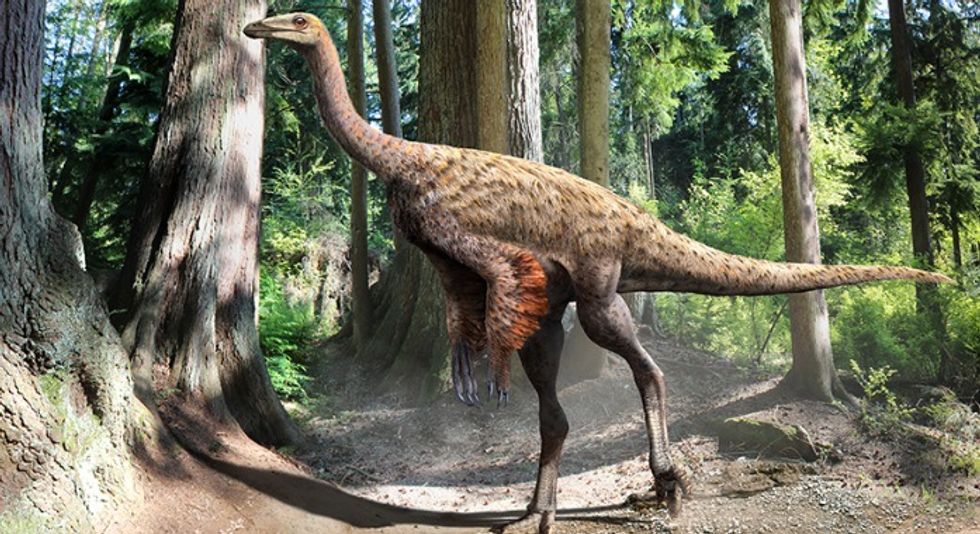
An illustration depicting what Ornithomimus might have looked like. (Julius Csotonyi via the University of Alberta)

Picture a dinosaur, any dinosaur.
You're probably envisioning a large, toothy creature with a thick, scaly exterior, no?
A recently announced discovery is adding more evidence that constructs a view of dinosaurs that weren't so exclusively scaly.
The idea that some dinosaurs had feathers and have an evolutionary linkage to birds is nothing new, but the discovery of a dinosaur fossil by an undergraduate paleontology student is adding more support to this connection.
Aaron van der Reest, as a student at the University of Alberta in Canada, discovered a dinosaur fossil with preserved tail features and some soft tissues in Alberta’s Dinosaur Park. According to National Geographic, the discovery of the Ornithomimus, which lived in the Cretaceous period, was made in 2009, but the research announcing it was only recently published in the journal Cretaceous Research.

This, according to the study authors, is the "first report of such soft tissue structures in non-avian theropods" and the first of the genus to have tail feathers so extensively preserved. It is not, however, the first Ornithomimus fossil to be found with feathers, though it is rare. According to the university's news release, it is one of three.
"It’s pretty remarkable. I don’t know if I’ve stopped smiling since," Philip Currie, a paleontologist who supervised Reest's, work said in a statement.
Though the features were described as "extremely crushed" by the university, using scanning electron microscopy the researchers were able to reconstruct the 3-D keratin structure of the feathers.
"We now know what the plumage looked like on the tail, and that from the mid-femur down, it had bare skin,” van der Reest said in a statement. “Ostriches use bare skin to thermoregulate. Because the plumage on this specimen is virtually identical to that of an ostrich, we can infer that Ornithomimus was likely doing the same thing, using feathered regions on their body to maintain body temperature. It would’ve looked a lot like an ostrich.”
The researchers observed that the top of dinosaur's tail feathers were "slightly more elongate in comparison to those present on the remainder of the body," while the underside of the tail and the creature's leg up to its femur did not have any plumage.
“Ostriches use bare skin to thermoregulate," van der Reest told the Edmonton Sun. "Because the plumage on this specimen is virtually identical to that of an ostrich, we can infer that Ornithomimus was likely doing the same thing, using feathered regions on their body to maintain body temperature."
One of the study's authors Alex Wolfe said in a statement that this discovery "tightens the linkages between dinosaurs and birds, in particular with respect to theropods,” a type of dinosaur.
“There are so many components of the morphology of this fossil as well as the chemistry of the feathers that are essentially indistinguishable from modern birds," Wolfe added.
Even as new discoveries are lending more evidence to feathered dinosaurs, research published earlier this year suggested that most dinosaurs were still of the scaly variety.
---